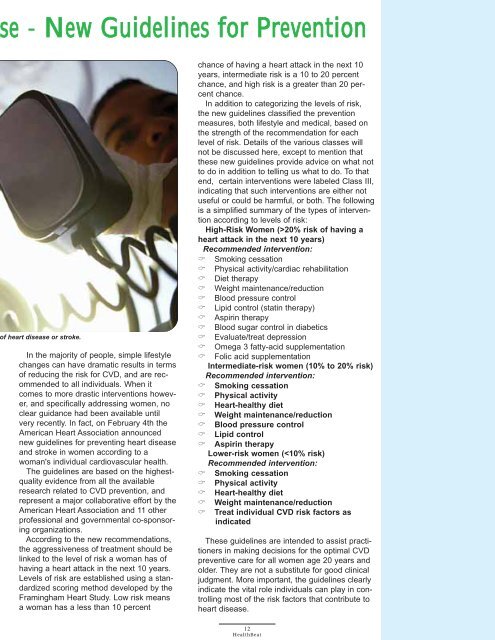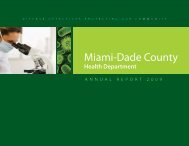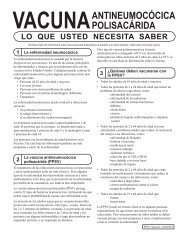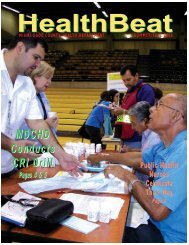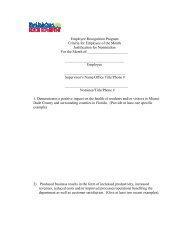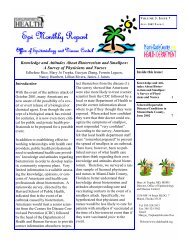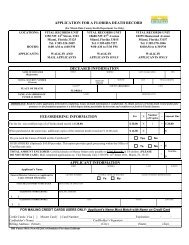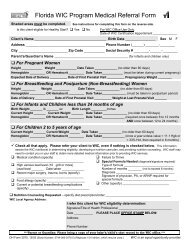MIAMI-DADE COUNTY HEALTH DEPARTMENT SPRING 2004 ...
MIAMI-DADE COUNTY HEALTH DEPARTMENT SPRING 2004 ...
MIAMI-DADE COUNTY HEALTH DEPARTMENT SPRING 2004 ...
You also want an ePaper? Increase the reach of your titles
YUMPU automatically turns print PDFs into web optimized ePapers that Google loves.
e - New Guidelines for Prevention<br />
f heart disease or stroke.<br />
In the majority of people, simple lifestyle<br />
changes can have dramatic results in terms<br />
of reducing the risk for CVD, and are recommended<br />
to all individuals. When it<br />
comes to more drastic interventions however,<br />
and specifically addressing women, no<br />
clear guidance had been available until<br />
very recently. In fact, on February 4th the<br />
American Heart Association announced<br />
new guidelines for preventing heart disease<br />
and stroke in women according to a<br />
woman's individual cardiovascular health.<br />
The guidelines are based on the highestquality<br />
evidence from all the available<br />
research related to CVD prevention, and<br />
represent a major collaborative effort by the<br />
American Heart Association and 11 other<br />
professional and governmental co-sponsoring<br />
organizations.<br />
According to the new recommendations,<br />
the aggressiveness of treatment should be<br />
linked to the level of risk a woman has of<br />
having a heart attack in the next 10 years.<br />
Levels of risk are established using a standardized<br />
scoring method developed by the<br />
Framingham Heart Study. Low risk means<br />
a woman has a less than 10 percent<br />
chance of having a heart attack in the next 10<br />
years, intermediate risk is a 10 to 20 percent<br />
chance, and high risk is a greater than 20 percent<br />
chance.<br />
In addition to categorizing the levels of risk,<br />
the new guidelines classified the prevention<br />
measures, both lifestyle and medical, based on<br />
the strength of the recommendation for each<br />
level of risk. Details of the various classes will<br />
not be discussed here, except to mention that<br />
these new guidelines provide advice on what not<br />
to do in addition to telling us what to do. To that<br />
end, certain interventions were labeled Class III,<br />
indicating that such interventions are either not<br />
useful or could be harmful, or both. The following<br />
is a simplified summary of the types of intervention<br />
according to levels of risk:<br />
High-Risk Women (>20% risk of having a<br />
heart attack in the next 10 years)<br />
Recommended intervention:<br />
Smoking cessation<br />
Physical activity/cardiac rehabilitation<br />
Diet therapy<br />
Weight maintenance/reduction<br />
Blood pressure control<br />
Lipid control (statin therapy)<br />
Aspirin therapy<br />
Blood sugar control in diabetics<br />
Evaluate/treat depression<br />
<br />
<br />
<br />
<br />
<br />
<br />
<br />
<br />
<br />
<br />
<br />
<br />
<br />
<br />
Omega 3 fatty-acid supplementation<br />
Folic acid supplementation<br />
Intermediate-risk women (10% to 20% risk)<br />
Recommended intervention:<br />
Smoking cessation<br />
Physical activity<br />
Heart-healthy diet<br />
Weight maintenance/reduction<br />
Blood pressure control<br />
Lipid control<br />
Aspirin therapy<br />
Lower-risk women (


